|
Social
News In Brief 23/5
Working for safer buildings in smart cities

At the workshop
The use of smart fire prevention and detection
technology is essential to ensure safety for buildings in smart cities, heard
a workshop in Ho Chi Minh City on May 22.
US Consul General in Ho Chi Minh City Mary Tarnowka
said the rapid urbanisation is putting a lot of pressure on infrastructure
and accommodation in HCM City.
It is necessary to build quality inspection programmes
and apply the latest technology for houses, offices, and public facilities to
ensure their safety, she said.
The recent deadly blaze at the Carina Plaza apartment
complex in the city’s District 8 has raised the issue of preventing losses by
pouring more investment in safety training and assessment, she added.
Major General Doan Viet Manh, head of the police
department for fire prevention and rescue under the Ministry of Public
Security, called on investors to select the state-of-the-art technology for
fire prevention and install smart fire warning systems in buildings.
Pham Minh Ha, head of the State department on assessing
quality of construction work under the Ministry of Construction, said the
ministry will strengthen coordination with the Ministry of Public Security to
inspect the maintenance of fire prevention systems in buildings and strictly
handle any violations.
The ministry is carrying out a project on fire safety
and increasing the dissemination of life-saving skills for tenants in
buildings, he noted.
According to the Construction Ministry, about 600 out
of 2,500 old apartment buildings in Vietnam are in dangerous or seriously
dilapidated conditions, making up some 25 percent of the total number of old
buildings.
In Hanoi and Ho Chi Minh City which accommodate most
old buildings, about ten buildings have been renovated or reconstructed,
while the rest are being assessed and expected to be put into the renovation
scheme by 2020.
Artistic programme marks 25 years of action for
biodiversity
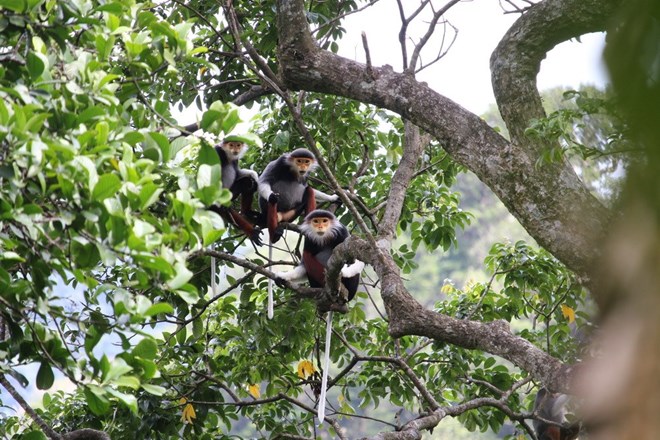
Red-shanked douc
(Pygathrix nemaeus) in Dong Chau-Khe Nuoc Trong forest in Quang Binh
province
An artistic programme was held in Hanoi on May 22 to
celebrate a quarter century of action for biodiversity, marking the 25th
anniversary of the Convention on Biological Diversity (CBD).
The event, held by the Ministry of Natural Resources
and Environment and the United Nations Development Programme (UNDP), was
attended by guests from Vietnamese and foreign agencies and organisations,
experts in biodiversity conservation and students.
Since Vietnam ratified the CBD on October 17, 1994, it
has made great strides in nature and biodiversity conservation, including
building a system of managerial agencies and a policy and legal framework on
biodiversity, setting up nature reserves and implementing action plans to
protect endangered fauna and flora species.
The country has stepped up efforts in new biodiversity
conservation issues like biological safety, access to genetic resources and
sharing of benefits from the use of genetic resources. Meanwhile, awareness
of the importance of biodiversity to life and sustainable development has
been improved.
Vietnam boasts high biodiversity with various types of
forests, swamps, rivers, streams and coral reefs, making it home to about 10
percent of the world’s animal species.
However, the country is facing risks of biodiversity
degradation and ecological imbalance, which will affect the human living
environment and the Earth’s development. Therefore, biodiversity conservation
needs multilateral cooperation and engagement from the entire society to
reach the targets in the CBD and the National Biodiversity Strategy.
Addressing the ceremony, UNDP Deputy Country Director
in Vietnam Akiko Fujii said biodiversity in Vietnam has brought benefits to
the people and contributed to the economy.
She noted it is a fact that biodiversity in the country
is being degraded, and the number of endangered species is increasing. Hence,
it is critically important to improve public awareness of biodiversity and
reasonably use biodiversity resources.
At the ceremony, participants also joined a discussion
on conservation with representatives of the Vietnam Environment
Administration, the Vietnam Association for Conservation of Nature and
Environment, the UNDP and ASEAN Biodiversity Hero Dang Huy Huynh.
Public, private agencies commit to achieve green growth
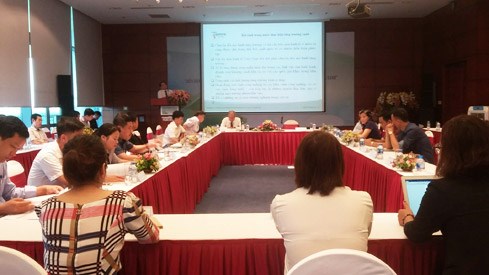
The Vietnam Environment
Forum takes place in Hanoi on May 22 under the theme “Enterprises towards
environment protection and green growth” (Photo: daibieunhandan.vn)
Protecting the environment is now becoming a common
motivation of enterprises’ long term strategy, Nguyen The Chinh, head of the
Institute of Strategy and Policy on Natural Resources and Environment said at
a forum on May 22.
The Vietnam Environment Forum themed “Enterprises
towards environment protection and green growth” hosted by Tai nguyen va Moi
truong (Natural Resources and Environment) magazine attracted the
participation of ministries’ representatives, experts and companies in Hanoi
and other localities.
According to Chinh, investment into organic and green
agriculture has generated good profits for a lot of Vietnamese firms. Besides
this, more and more enterprises are stepping into the industry of waste
collection and treatment, as well as environmental protection programmes.
By investing in eco-friendly industries and
innovations, enterprises can enjoy positive benefits while spreading
sustainable values to the community and country, experts agreed.
They noted that enterprises could definitely improve
labour productivity by ensuring a safe and healthy working environment for
workers. They can also avoid legal risks by strictly complying with
environmental regulations and investing into effective waste treatment
systems.
Therefore, on the occasion, experts and businesses
asked related ministries, State agencies and the Government to complete the
legal framework of natural resources management and environmental protection
to create favourable conditions for enterprises to approach innovations and
achieve the green growth.
In another development, the Mekong Delta province of
Bac Lieu affirmed a commitment to reduce greenhouse gas emissions,
effectively use natural resources and improve climate change resilience by
2020 with a vision to 2025.
Specifically, Bac Lieu province expects to reduce its
greenhouse gas emissions by up to 10 percent by 2020, and up to 79 percent by
2025. Furthermore, it is set to have 80 percent of manufacturing facilities
meeting the national environment standards by 2020.
To attain these goals, the local authorities have
implemented several solutions to raise awareness of the people, reduce
greenhouse gas emissions in the sectors of agriculture, forestry, fisheries
and industry, and foster sustainable consumption among consumers.
Duong Thanh Trung, Chairman of the provincial People’s
Committee, stressed green growth as the cornerstone of the province’s
socio-economic development, indicating the province’s commitment in realising
the national strategy of green growth and climate change resilience.
Gia Lai reburies remains repatriated from Cambodia
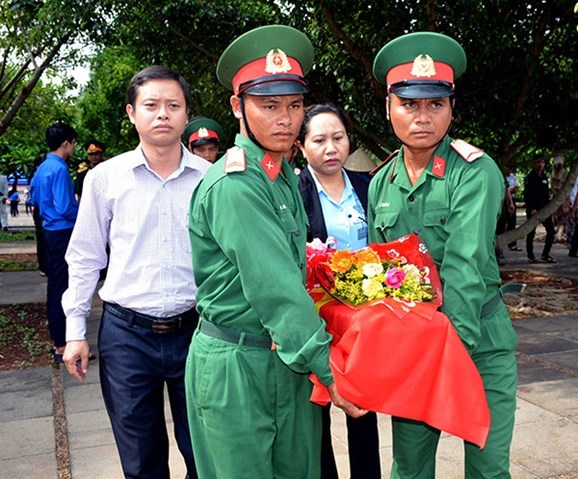
Scene at the event
(Photo: qdnd.vn)
The Central Highlands province of Gia Lai on May 22
held a ceremony to rebury the remains of 21 Vietnamese volunteer soldiers who
laid down their lives in Cambodia during wartime.
The ceremony was attended by the provincial leaders,
representatives from local organisations, military forces, and people from
all walks of life.
With support from authorities in the Cambodian
provinces of Rattanakiri, Preah Vihear and Stung treng and the Cambodian
Royal Army, the remains were found in the 2017-2018 dry season by Group K52
of the Gia Lai Military Command.
Established in 2001, Group K52 has to date found 1,400
remains of Vietnamese soldiers and experts fallen in Cambodia.
The remains were repatriated and reburied at Duc Co
Martyrs' Cemetery in Gia Lai’s Duc Co district.
Forum spotlights partnership in biodiversity protection
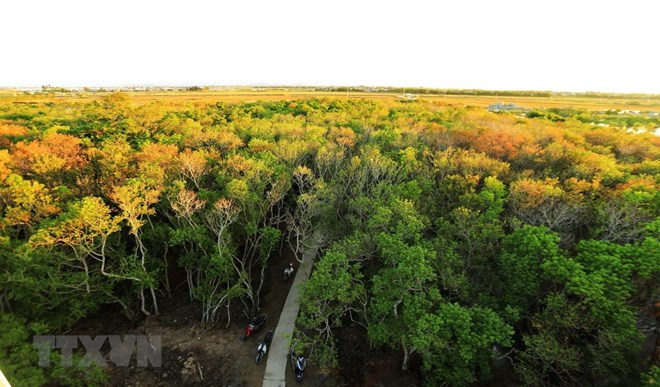
A view of Ru Cha
submerged forest in Huong Tra township, Thua Thien-Hue province
A biodiversity conservation partnership forum was held
in Hanoi on May 22 by the United Nations Development Programme (UNDP), the
Vietnam Association for Conservation of Nature and Environment and CropLife
Vietnam.
According to the Vietnam Environment Administration,
since Vietnam ratified the Convention on Biological Diversity in October 17,
1994, the country has made strides in protecting the nature and biodiversity,
building a system of management agencies as well as legal and policy
frameworks on biodiversity.
A system of wildlife reserves has been set up, while
many endangered species of animals and plants have been protected by the law
and through action plans. Vietnam has also sped up the settlement of new issues
related to biodiversity conservation such as biological safety, genetic
resource access and interest sharing from using genetic resources.
The public awareness of the significance and role of
biodiversity to the life and national sustainable development has been
improved.
Participants at the event agreed that with diverse
terrains, land types, landscapes and climate, Vietnam is one of the countries
that have high biodiversity, along with high risks of biodiversity
degradation and imbalance, which has directly affected the living environment
of people and threatened the country’s sustainable growth.
The protection of biodiversity requires cooperation of
many parties and strong engagement of the whole society, with the aim of
fulfilling the targets of the Convention on Biological Diversity as well as
the national strategy on biodiversity.
Hoang Thi Thanh Nhan, Vice Director of the Department
of Nature and Biodiversity Conservation under the Vietnam Environment
Administration, said that four major areas in the partnership programme in
the 2015-2020 include the building of policies and laws; the protection of
endangered species and wildlife trafficking prevention; biodiversity and
climate change; and economic tools and community-based conservation.
From May 2018, as the department will also be in charge
of protecting natural heritage and biosphere reserves, it needs more
cooperation from domestic and foreign partners.
“Don’t play with natural disasters” wins first prize of
film contest
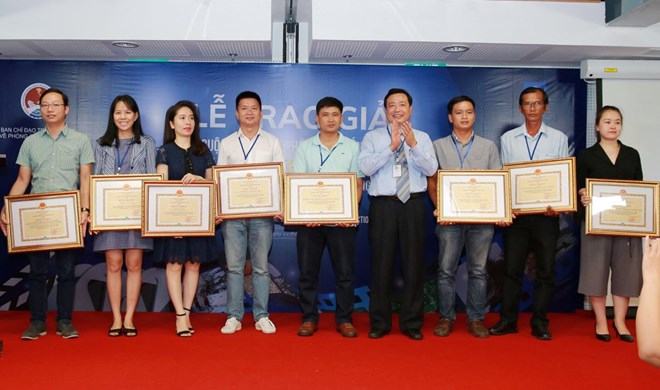
Winners of the film
contest
The nine-minute documentary “Dung dua voi thien tai”
(Don’t play with natural disasters) by Khanh Hoa province’s TV and Radio won
the first prize of the short reportage and film contest, themed “Extreme
natural disasters – lessons of the past and ideas for future actions”.
The Central Steering Committee for Natural Disaster
Prevention and Control and the United Nations Development Programme (UNDP)
held the awards ceremony in Hanoi on May 22.
The winning documentary reveals how a storm destroyed
all the life savings of local people in the central coastal province of Khanh
Hoa early in the morning of November 4, 2017.
The organisation board also presented a second prizes
to “Lu quet Mu Cang Chai – Nguyen nhan hinh thanh va Moi so giai phap (Flash
Floods in Mu Cang Chai – Causes and Solutions) by Vietnam Television and
“Chuyen cai ao” (The Story of a Pond) by Soc Trang TV and Radio. Three third
prizes and three consolation prizes were also awarded.
Speaking at the awards ceremony, permanent member of
the Central Steering Committee for Natural Disaster Prevention and Control
Tran Quang Hoai highlighted the crucial role of the media in reducing
destruction caused by natural disasters.
Natural disaster predictions and warnings need to be
disseminated quickly and precisely to the public via different means, he
added.
Caitlin Wiesen, UNDP Country Director in Vietnam, said
the competition recognised the importance of the media in providing knowledge
and skills to contribute to natural disaster prevention efforts.
At the end of the awards ceremony, the 2018 contest
with the theme “Minimising destruction caused by natural disasters and proactively
adapting to climate change starting from communities” was launched.
The contest aims to improve media coverage of natural
disaster preparedness and improve public awareness of disasters.
It also supports the realisation of targets set out in
the Sendai Framework for Disaster Risk Reduction and the Sustainable
Development Goals of the United Nations Office for Disaster Risk Reduction.
Over the past 20 years, natural disasters have left
some 400 dead and missing and caused economic damage of about 1-1.5 percent
of the country’s gross domestic product (GDP) yearly.
2017 was considered a year of extreme weather, with
heavy and prolonged downpours, landslides, flashfloods and storms resulting
in 386 dead and missing and some 60 trillion VND (2.6 billion USD) worth of
damage.
Trial for deadly medical accident resumes with new
details

The first-instance trial
for the accident at Hòa Bình General Hospital that killed nine people in May
last year ended its sixth day on May 22 with a series of question and answer
among defendants and the board of judges.
The first-instance trial for the accident at Hòa Bình General Hospital that killed nine people in May last year ended its sixth day on May 22 with a series of question and answer among defendants and the board of judges. In the morning session, the court presented the testimonies of Trương Quý Dương, who was director of Hòa Bình Hospital when the accident occurred, and Trần Văn Thắng, the head of the hospital’s equipment department. On May 29, 2017, 18 patients suffered symptoms of anaphylactic shock while receiving kidney dialysis at the kidney dialysis division of the Hòa Bình General Hospital’s Department of Intensive Care. Nine patients died. Dương and Thắng were asked to show up to the court as persons related to the case but they refused, so the court had to present their testimonies. According to the statement Dương gave to the Hòa Bình Province’s Police, he said the dialysis section belonged to the intensive care department. Doctor Hoàng Công Lương was assigned to give medical treatment to the patients and take part in giving first aid within the intensive care department in case of emergency or accidents. However, doctor Lương disputed Dương’s testimony about his assignment at the hospital. Lương said that he was a doctor in the intensive care department, not the dialysis section. Also in the court session on Monday, Đinh Tiến Công, chief nurse of the intensive care department, affirmed that Lương’s assignment was chief doctor of the dialysis section. Regarding the responsibilities of the hospital’s equipment department headed by Thắng, Dương said the department was responsible for purchasing, providing and maintaining machines and equipment used in the hospital. The department’s staff had to regulate the RO water filter system for dialysis machines. He said he did not know the Thiên Sơn Company, which signed a contract to provide equipment to the hospital, had resold the contract to Trâm Anh Company. Meanwhile, Thắng said that defendant Trần Văn Sơn, who had worked at the department since August 2013, was in charge of managing files of medical equipment and verifying the equipment’s quality, including maintaining and repairing equipment in the dialysis section, intensive care and eye departments. Thắng said Sơn did not give him any records relating to repairing the RO system of the dialysis section with Bùi Mạnh Cường, director of Trâm Anh Company. The defendant Trần Mạnh Sơn disputed Thắng’s testimony. The defendants include Bùi Mạnh Quốc, director of the Trâm Anh Water Treatment Co Ltd and a resident of the northern province of Bắc Ninh, who was prosecuted for “unintentionally causing deaths.” The others are Trần Văn Sơn, an official of the medical material and equipment division of the Hòa Bình General Hospital, and Hoàng Công Lương, a doctor of the Department of Intensive Care of Hòa Bình General Hospital. Both Sơn and Lương were prosecuted for “lacking responsibility causing serious consequences.” According to the indictment of the provincial People’s Procuracy, Quốc had repaired and maintained the RO filter system of the dialysis machines. During the process, however, the machines’ water supply tubes were not purified carefully, leaving a chemical residue. After the pasteurisation of the RO filter system, Quốc failed to check the quality of water samples before handing the system over to the hospital. He was charged with “unintentionally causing deaths.” Sơn, 28, who was in charge of checking and supervising the replacement and maintenance of the filter system, failed to complete his assigned tasks. Nephrologist Lương, 32, allowed the dialysis treatment to commence without checking the water quality of the machines.
Efforts to erase mother-to-child transmission of HIV,
hepatitis B, syphilis
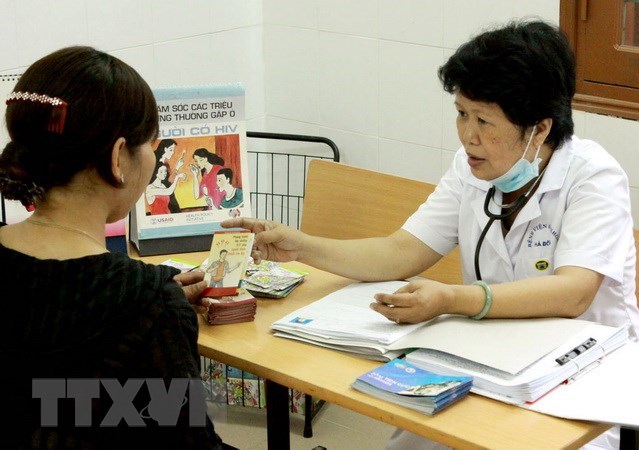
A workshop was held in Hanoi on May 22 to gather ideas
for the building of a national action plan to eliminate the transmission of
HIV, hepatitis B and syphilis from mothers to children.
Addressing the event, Deputy Minister of Health Nguyen Viet Tien noted that the transmission of these diseases from mother to child causes many consequences, greatly affecting the health of mothers and children, stressing the ministry’s determination to complete the goals of erasing mother-to-child transmission of these diseases. He said that pregnant women lack access to health services in remote, border and island areas, creating a major challenge for the national programme to eliminate the diseases. The Ministry of Health’s Maternal and Child Health Department reported that the rate of HIV infection among the country’s two million pregnant women every year is 0.25 percent. At the same time, Vietnam is one of the countries with the highest prevalence of hepatitis B virus in the world, at 10-20 percent. Therefore, the prevalence of hepatitis B virus among pregnant women is also high. According to the Central Dermatology Hospital’s latest report, the incidence of congenital syphilis in newborns is on the rise. A draft on the National Action Plan to eliminate the transmission of HIV, hepatitis B and syphilis from mothers to children in the 2018-2030 period has been completed by the Ministry of Health. The plan will focus on key solutions: strengthening communication and finance, innovating new methods of treatment and enhancing the quality of health services such as screening, diagnosis, care and treatment for mothers and children. At the workshop, participants discussed issues such as antenatal care and pre-testing for disease discovery, interventions for pregnant women, mother-to-child transmission, funding for the implementation of the plan, inter-sector coordination and monitoring. According to the World Health Organisation (WHO), in the western Pacific Region, every year, about 180,000 people are infected with hepatitis B, 13,000 children are infected with syphilis and 1,400 children are infected with HIV. These diseases can be prevented through simple and accessible interventions, including pre-testing for pregnant women and vaccination of infants after birth. Participants at the workshop agreed that in Vietnam, there is a lack of coordination among medical service providers such as clinics, hospitals and grass-roots health centres. This restricts mothers and infants from accessing advanced medical services and limits the effectiveness of medical intervention. WHO has developed a framework for the elimination of HIV, hepatitis B and syphilis from mothers to children in the Asia-Pacific region for the 2018-2030 period and recommended member states develop national action plans to eliminate mother-to-child transmission of the three diseases by 2030.
VNN
|
Thứ Năm, 24 tháng 5, 2018
Đăng ký:
Đăng Nhận xét (Atom)
Không có nhận xét nào:
Đăng nhận xét